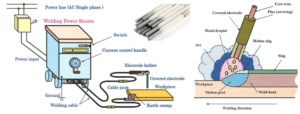
Nikolaus Zauner, Product Manager Welding Education;
Fronius International GmbH

Josef Kreindl,
Welding Business Academy;
Fronius International GmbH
Abstract:
The demand for highly qualified welding engineers remains as high as ever. This means that different approaches have to be adopted in order to tempt the younger generation to consider this sector. Compared with just 20 years ago, technical expertise is now being made available and imparted in a completely new way. New technology has encouraged the development of new learning formats, so instead of reaching for a textbook or data sheet, the first port of call when searching for information nowadays is more likely to be Google or YouTube. Increasing digitization is also impinging on the field of knowledge sharing. eLearning tools use digital media to enable teaching content, such as welding knowledge, to be conveyed in a simple way. Welding technology must also learn how to take advantage of this potential.
So what contribution can a power source manufacturer like Fronius make? The interaction between man and welding system is already reality. Tried-and-tested welding parameters can be saved as jobs and transferred to other devices. The system will even step in if predefined limits are exceeded, making it easier to detect errors at an early stage and to optimize production processes. Digital displays on the devices also simplify the input of the correct welding parameters. Smartphones are another tool that can help welders in their day-to-day activities. Free apps, such as WeldConnect and Welducation Basic from Fronius, enable the suitable parameters for a welding task to be found quickly or provide welding knowledge in an easy to follow way. Welding instructors working in training centers can download training material that conforms to IIW guidelines (International Institute of Welding). All these factors underline the huge potential of the new digital media for welding technology – particularly for training purposes and knowledge sharing.
- Training and learning in the Digital Age
It is hard to image finding our way around nowadays without the help of a smartphone or a sat-nav system, primarily because they are so accurate and easy to use. Many software packages have meanwhile established themselves in our working lives and have replaced classical elements, such as the street map in this example. How we obtain our information has undergone a fundamental change over the past two decades. In the past, our main fount of knowledge was a textbook or the library, but nowadays it’s the internet. Information on the web can be retrieved from anywhere and at any time. The amount of information available online about welding is rising exponentially. Many manufacturers of power sources, filler metals, and accessories are now uploading basic information and video clips to the web, while the websites of trade associations and educational establishments also contain a wealth of information about welding technology.
Children too are being exposed to the new digital media. They are growing up with it and become media-savvy at a frighteningly early age. Animations and videos teach them everything they need to know about the processes in a playful way, so they quickly develop a sound basic understanding. Didactic concepts lie at the heart of this knowledge sharing process, but a visit to a welding technology educational establishment can give one the impression that time is standing still. The graphics and information presented in training material often depict obsolete welding systems (Figure 1).

Fig 1: Principle behind a manual arc welding station.
2. Learning welding in the real world
The practical component of a welding training session involves the instructor demonstrating the respective operation in front of the whole group (Figure 2). The students then perform the operation in their own cabin, which means they do not receive any support until they have completed the exercise, when the weld is examined by the instructor. Feedback during the welding operation itself is often not possible, unless the instructor monitors the relevant operation in the cabin itself. This means that torch guidance errors are not detected and corrected until far too late in the process.

Fig 2: Initial welding of a practical exercise.
3. Digital Tools to the Rescue
The actual arc time available to the student to learn the necessary skills is reduced by a number of ancillary activities. Welding simulators (Figure 3) have now been in use for almost ten years in an attempt to increase the arc time and improve group dynamics. Commercial factors are the main reason: less use of consumables and a lower risk of injury.

Fig 3: Welding simulators in welding training.
The response of instructors to welding simulators and other digital tools has, however, been muted. There are a variety of reasons for this: on the one hand are the extremely tight time constraints that the students have to contend with in order to obtain a certificate conforming to ISO EN 9606; furthermore, there is a lack of didactic concepts dictating how and to what extent these simulators can be used. How the weld seam is portrayed frequently differs markedly from how it appears in real life.
Simulators and new welding apps (Figure 4) sometimes appear too complex to operate, which discourages their use. Alternatively, they’re likely to be seen as toys. The lasting benefits of these new technologies need to be explained to the older generation in particular. Millennials and Generation Z, by contrast, are much more comfortable with them. They have grown up in the internet age and feel totally at home in a digital environment. It has even been known for young students to display a greater understanding of the use of the new digital welding technology tools than the instructors themselves.

Fig 4: Use of apps in welding training.
The objective of organizations and educational establishments tasked with welding training should be to develop digital teaching concepts in close collaboration with manufacturers and suppliers, and to deliver these to welding instructors as a curriculum that is tailored to the needs of the target group. The respective preconfigured teaching module can then be implemented quickly, as and when required. However, the main focus must remain on simple operation and the actual benefit to the student.
Depending on the level of knowledge and experience, different versions of welding simulators with varying equipment levels can be a big advantage. A beginner, for example, can use the free apps to learn about welding technology in an approachable way (Figure 5). Schools and training organizations, on the other hand, prefer to use existing IT hardware while retaining the ability to integrate new didactic training material. Fully configured high-end devices offer even more options: from training mode to simulation mode through to real-life welding. The content of all these versions should be coordinated and compatible.

Fig 5: Location-independent welding training.
The curricula and staffing plans must ease the pressure on the instructors rather than add to it. The requirements extend from the simple configuration of a system through to evaluation of the training results. Well-prepared and important theoretical aspects of the training can play a major role in increasing efficiency levels.
Students are able to check on their progress and brush up on what they’ve learned at any time. They can login online and study the theory at home or while they’re out and about. Online tests, such as provided in the Welducation Basic app, help students revise what they’ve been taught. A points system gives students an indication of how well prepared they are.
4. Conclusion
Digitization is all around us and welding technology is no exception. Digital applications in welding systems have been with us for a long time. The development of new software and systems simplifies the working lives of welders and welding coordination personnel, for example by carrying out an analysis of welding parameters and limits. The wireless transfer of defined and tried-and-tested welding parameters and machine settings to another system is already possible. What still needs to be improved is the collaboration between organizations and simulator manufacturers to overcome the challenges to the successful uptake of this new development. Welding training must also embrace new information and communication technologies to ensure that welding remains an attractive career option for the next generation. Let’s confront these challenges together to provide a pool of highly qualified welders for the years ahead.

Fig 6: On-site welding training.






